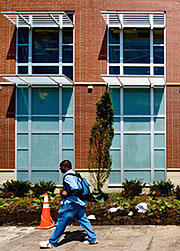Light Shelves: How to Maximize Daylight Penetration
Windows receive a large amount of energy from the sun. Most of this is wasted on a single area, and direct sunlight causes harmful glare on desks and computer monitors. In fact, a single south-facing window can illuminate up to 20 to 100 times its unit area. This light can be a nuisance if concentrated in one spot, but is extremely useful if distributed to all parts of the room equally.

Light shelves bounce visible light up towards the ceiling, which reflect it down deeper into the interior of a room. External and internal light shelves mounted on the south- and west-facing windows can redistribute light throughout a building, providing natural brightness and reducing the need for daytime overhead lighting.

For best results, light shelves should be mounted horizontally. If the surface of the shelf is highly reflective, then the angle that the sunlight is reflected onto the ceiling will be equal to the angle of incidence of the incoming sunlight. For a more diffuse spread of light, shelves can be painted with rougher, less mirror-like materials. This will scatter the light at many different angles, providing a more diverse coverage area on the ceiling. The ceiling should be painted with a reflective paint in a light colour, to bounce the light back down onto the work area.
Each internal light shelf is mounted 2.1 meters (7 feet) high, to eliminate the possibility that glare will be reflected into the eyes. There is also a safety reason for this: obviously internal shelves must be above head-height. External shelves are best paired with internal shelves and mounted at the same height.
Blinds can be installed above and below the light shelves so that users are able to adjust the brightness of the room for individual comfort at different times of day.
Direct sunlight can heat up a room by several degrees, an effect is called solar heat gain. Because of the light dispersal effect, the heat energy that is added to a room by a light shelf is only slightly more than the heat generated by standard electric lighting. The benefit, of course, is the power consumption for this lighting - none.
The following rules of thumb are relevant for projects located in the Northern Hemisphere:
- Light shelves are most effective with south-facing glass.
- Light shelves are not very effective with east- and west-facing glass. Limiting the size of windows and using blinds or shades are more effective ways to minimize thermal heat gain and control glare from the low sun angles on these exposures.
- Light shelves are not effective with north-facing glass. North-facing skies provide diffuse daylight rather than direct sunlight for much of the year.
- Light shelves are not very effective on any building where the number of overcast days is significantly higher than the number of clear, sunny days at the project location.
- Matte is the recommended finish for the top of the light shelf to diffuse the direct sunlight, which will minimize glare and provide uniform distribution of light inside the room. (Highly specular finishes are currently being studied to maximize daylight penetration; however, diffuse finishes are recommended until more information and design guidelines are defined.)
Light Shelves: How to Maximize Daylight Penetration copyright 2011 Digtheheat.com
